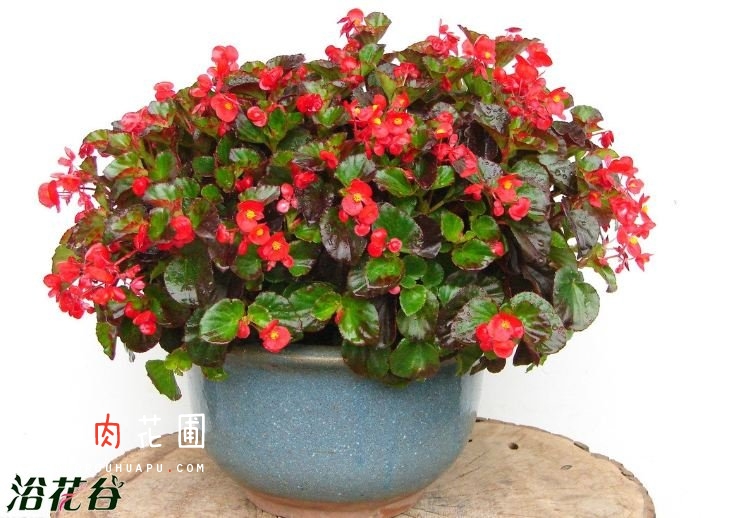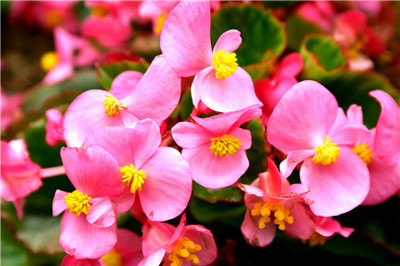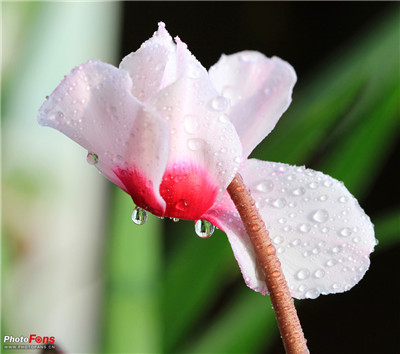Culture methods and matters needing attention of Begonia in four seasons
Begonia can be said to be the most popular flower in China, so many people raise crabapple flowers at home, especially the four seasons crabapple, which has the advantages of round plant type, many and dense flowers, easy to plant with other flower bed plants, and long viewing period of flowering in four seasons, so it is more and more popular. The four seasons crabapple likes a warm and humid environment, and is afraid of cold, early morning, extreme heat and waterlogging, so it grows best in a semi-overcast, humid and warm environment.

The cultivation method of four seasons begonia is first, basin soil, which is best prepared by the mixture of river sand, rotten leaf soil and snake sawdust. Begonia in the four seasons is afraid of the heat, so it should be kept in a cool place in summer. Second, watering, four seasons crabapple likes warm and moist conditions, so during the growth period, it should be watered according to plant growth and temperature changes. Less watering during the budding period, keep the basin soil slightly dry, if too wet will lead to rotting roots. During the growing period, water is watered every two days, and water is often sprayed around the plant to increase air humidity. In addition, it should be noted that when watering, do not water the leaves and the top of the stem, but along the edge of the flowerpot, otherwise the stems and leaves are prone to water rot. Third, fertilization, four seasons crabapple in the growth period should be according to the plant leaf color and leaf growth quietly apply fertilizer, can not fertilize too much, otherwise it will lead to excessive leaf growth, affecting flowering. Appropriate amount of phosphate and potash fertilizer should be applied before flowering to improve flowering quality. Fourth, when winter comes, we should dig up the bulbs and hang them in a dry and ventilated place or put the potted flowers in a warm place indoors to survive the winter. Fifth, disease prevention, four seasons crabapple in the high temperature drying period, prone to root rot and stem rot. At the initial stage of discovery, watering should be controlled in time, and carbendazim should be sprayed to control. The curative effect can be seen after continuous use for a period of time. Sixth, winter and summer management, due to the influence of temperature in winter and summer, the growth is relatively slow, so it is necessary to strengthen the management of fertilizer and water. Seventh, sunshine, in the hot summer season, we must avoid the four seasons begonia by the direct light, so that it will sunburn the four seasons crabapple. Eighth, the four Seasons Begonia must remember to remove the heart and remove the residual flowers in time after the flower fade, so that it can grow more luxuriantly. Ninth, pests, the common pest of Begonia is leaf roll moth, which eats young leaves and flowers with larvae, which directly affects the growth and development of Begonia. For this situation, if it is not particularly serious, it can be caught manually. For serious ones, it should be sprayed with dimethoate. The flowerpots of crabapple of the tenth and fourth seasons should be placed on the balcony or the semi-shade of the courtyard at ordinary times, do not let the sunlight come in directly, and pay attention to ventilation. After planting crabapple for half a month, you can apply a mature fat and water. Every 20-30 days, apply light fat and water every 20-30 days. In winter, it should be moved indoors and placed in a sunny place, and the lowest temperature should not be less than 10 degrees. Note: ① fat. Spring and Autumn four crabapple needs to master the principle of applying thin fertilizer frequently for a long time, mainly applying rotten and odorless organic fertilizer water or inorganic fertilizer soaking solution. More nitrogen fertilizer is applied in the seedling budding stage to promote the growth of branches and leaves; in the budding and flowering stage, more phosphate fertilizer is applied to promote the gestation of flower buds, and the flowers are many and bright. if there is a lack of fertilizer, the four seasons begonia plants will wither or even die. ② water. Spring four begonia growth boom soil needs to contain more water, watering should be timely, keep moist. ③ summer overwintering management. Due to the influence of temperature in summer and winter, the growth is slow, so it is necessary to strengthen the management of fertilizer and water. In the high temperature season in midsummer, it is necessary to take measures to avoid strong direct light and cool down to create a small environment below 30 ℃, keeping the basin soil dry and wet, the roots are too wet and easy to rot, and the leaves will wilt if they are too dry, as long as they are slightly moist; if you apply too much fertilizer in this period, it will cause tender stems and leaves or rot disease. As long as the winter temperature is kept above 10 ℃, it can survive the winter safely. In summer and winter management, if the temperature can be controlled below 30 ℃, the temperature is above 10 ℃, the watering is dry and wet, and the fertilization is appropriate, the plant must be strong and blossom continuously in four seasons. Culture methods and matters needing attention of four-season Begonia
Crabapple flowers in four seasons have been loved by many people, so many people raise them in their own homes. There are many varieties of crabapple flowers in the four seasons, which have the advantages of round plant type, many and dense flowers, easy to plant with other flower bed plants, and long flowering and ornamental period in the four seasons. Let's take a look at the breeding methods and cultivation points for attention of the four seasons begonia.
Four Seasons Begonia Culture method 1. Four Seasons Begonia Culture: pot soil
The best mixture of river sand, rotten leaf soil and snake sawdust is the basin soil of crabapple in four seasons. Begonia in the four seasons is afraid of the heat, so it should be kept in a cool place in summer.
2. Begonia culture in four seasons: watering
Four Seasons Begonia likes warm and moist conditions, so during the growth period, it should be watered according to plant growth and temperature changes. Less watering during the budding period, keep the basin soil slightly dry, if too wet will lead to rotting roots. During the growing period, water is watered every two days, and water is often sprayed around the plant to increase air humidity. In addition, it should be noted that when watering, do not water the leaves and the top of the stem, but along the edge of the flowerpot, otherwise the stems and leaves are prone to water rot.
3. Four Seasons Begonia Culture: fertilization
The summer fertilization of four seasons begonia should be treated differently according to the new and old plants. For the new plants propagated in the autumn of the previous year, some mature thin cake fertilizer and water can be applied after each stubble, and the suitable fertilizer-water ratio is 1:5, once a week, twice a week, and can blossom again after two weeks. When the temperature is above 25 ℃, the old perennial plants or weakly growing plants should stop fertilization and wait until after the summer to usher in the second peak flowering season.
4. Winter maintenance of Begonia in four seasons
When winter comes, dig up the bulbs and hang them in a dry and ventilated place or put the potted flowers in a warm indoor place to survive the winter. Winter and summer management, due to the influence of temperature in winter and summer, the growth of begonia is relatively slow, so it is necessary to strengthen the management of fertilizer and water.
5. Four Seasons Begonia Culture: diseases and insect pests
During the period of high temperature drying, begonia is prone to root rot and stem rot. At the initial stage of discovery, watering should be controlled in time, and carbendazim should be sprayed to control. The curative effect can be seen after continuous use for a period of time. The common disease and pest of four seasons begonia is leaf roll moth, which eats young leaves and flowers with larvae, which directly affects the growth and development of four seasons begonia. For this situation, if it is not particularly serious, it can be caught manually, and serious ones should be sprayed with dimethoate diluent.
6. Four Seasons Begonia Culture: sunshine
In the hot summer season, be sure to avoid the four seasons begonia by the direct light, so that it will sunburn the four seasons crabapple.
7. Maintenance after flowering of four seasons crabapple
The four Seasons Begonia must remember to remove the heart and remove the residual flowers in time after the flower fade, so that it can grow more luxuriantly.
8. Four Seasons Begonia flowerpots
Usually should be placed on the balcony or courtyard semi-shade maintenance, must not let the sun come in, and should pay attention to ventilation, the four seasons begonia can be planted half a month later, after the growth period, every 20-30 days to apply light fat and water, winter should be moved into the room to be sunny enough, and the lowest temperature should not be less than 10 degrees.
9. Four Seasons Begonia Culture: shading and ventilation
Four seasons crabapple is very sensitive to sunlight, as soon as it enters summer, it is necessary to adjust the lighting time to create an environment that adapts to its growth. It should be shaded from 10 to 16:00 from the middle of May to the first ten days of June and from 8: 18 from the middle of June to the end of August. Indoor cultivated plants should be placed in a place with scattered light and good ventilation, and the windows should be opened at night for ventilation.
Matters needing attention in cultivation and culture of begonia in four seasons 1. Selection of seedlings
When buying seedlings, you should choose seedlings with large and complete leaves at the base and buds or branches in the axils. This kind of seedling has the characteristics of strong growth potential, many branches, flower reproduction and so on.
2. Prevent cold and keep warm in winter
Begonia in the four seasons is afraid of the cold, so we should do a good job of preventing cold and keeping warm as soon as possible. Move the basin into the south-facing sunny place in front of Frosts Descent. When the cold wave comes, you can cover it with a plastic bag and take it off the next day after the sun comes out. You can't put it next to the heater, otherwise the leaves will burn. Pay attention to ventilation in air-conditioned rooms.
3. Cooling and ventilation in summer
In summer, the basin should be placed in a cool, ventilated place, the temperature should be controlled below 30 ℃, avoid direct light, suffer burns.
4. Fertilizer and water management
In the growing season, thin liquid fertilizer is applied every 10 days or so, and quick-acting phosphorus and potassium fertilizer is applied during the formation of buds to make the flowers bright; watering should be dry and thoroughly, and pay attention to maintain humidity, and often spray water to the leaves, especially in hot summer and dry winter. It is better for basin soil to be slightly dry in summer and winter, which is beneficial to increase resistance, but can not be too dry. Take shelter from the rain.
- Prev

How to make the flowers and leaves of the four seasons crabapple green
In order to make the branches and leaves of the four seasons crabapple green and the flowers colorful, we should pay attention to the selection of ① seedlings in cultivation. When buying seedlings, you should choose seedlings with large and complete leaves at the base and buds or branches in the axils. This kind of seedling has the characteristics of strong growth potential, many branches, flower reproduction and so on. ② keeps warm against cold in winter
- Next

Flowering maintenance measures of cyclamen
Cyclamen is known as rabbit ear flower and monk hat flower because of its Corolla shaped like rabbit ear and monk's hat. Cyclamen flowers are solitary, the buds are drooping when the buds are developed, and gradually raise their heads tall and straight when they open. There are many colors, monochromatic and polychromatic; the flowering period is long, from December of each year to May of the following year
Related
- Fuxing push coffee new agricultural production and marketing class: lack of small-scale processing plants
- Jujube rice field leisure farm deep ploughing Yilan for five years to create a space for organic food and play
- Nongyu Farm-A trial of organic papaya for brave women with advanced technology
- Four points for attention in the prevention and control of diseases and insect pests of edible fungi
- How to add nutrient solution to Edible Fungi
- Is there any good way to control edible fungus mites?
- Open Inoculation Technology of Edible Fungi
- Is there any clever way to use fertilizer for edible fungus in winter?
- What agents are used to kill the pathogens of edible fungi in the mushroom shed?
- Rapid drying of Edible Fungi

